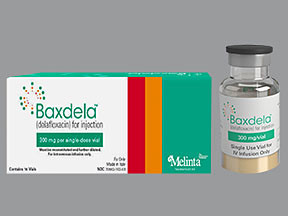DELAFLOXACIN - INJECTION
PHONETIC PRONUNCIATION: (DEL-a-FLOX-a-sin)
COMMON BRAND NAME(S): Baxdela
GENERIC NAME(S): delafloxacin meglumine
Uses
USES: Delafloxacin is used to treat a variety of bacterial infections. This medication belongs to a class of drugs known as quinolone antibiotics. It works by stopping the growth of bacteria. Delafloxacin injection is used if you cannot take the medication by mouth. This antibiotic treats only bacterial infections. It will not work for viral infections (such as common cold, flu). Using any antibiotic when it is not needed can cause it to not work for future infections.
How to use DELAFLOXACIN - INJECTION
HOW TO USE: Read the Medication Guide provided by your pharmacist before you start using delafloxacin and each time you get a refill. If you have any questions, ask your doctor or pharmacist. If you are using this medication at home, learn all preparation and usage instructions from your health care professional. Before using, check this product visually for particles or discoloration. If either is present, do not use the liquid. Learn how to store and discard medical supplies safely. This medication is given by injection into a vein, as directed by your doctor, usually every 12 hours over 60 minutes. The dosage and length of treatment are based on your medical condition and response to treatment. Drink plenty of fluids while using this medication unless otherwise directed by your doctor. For the best effect, use this antibiotic at evenly spaced times. To help you remember, use this medication at the same times every day. Continue to use this medication until the full prescribed amount is finished, even if symptoms disappear after a few days. Stopping the medication too early may result in a return of the infection. Tell your doctor if your condition lasts or gets worse.
Side Effects
Precautions
Interactions
Overdose
Images
Reviews
Faq for DELAFLOXACIN - INJECTION
Delafloxacin Injection is an antibiotic medication used to treat serious bacterial infections including skin and soft tissue infections.
Delafloxacin works by inhibiting the growth of bacteria and preventing their further multiplication, ultimately leading to the eradication of the infection.
Delafloxacin Injection is administered as an intravenous (IV) infusion. It should be given slowly over a period of one hour.
The recommended dosage of Delafloxacin Injection is 300 mg given intravenously every 12 hours for a total of 5 to 14 days, depending on the severity of the infection and the patient's response.
Common side effects of Delafloxacin Injection may include nausea, diarrhea, headache, dizziness, and injection site reactions. It is important to inform your healthcare provider if you experience any severe or persistent side effects.
There is limited information available regarding the use of Delafloxacin Injection during pregnancy. It should only be used if the potential benefits outweigh the potential risks to the fetus. Consult your healthcare provider before taking this medication if you are pregnant or planning to become pregnant.
The safety and effectiveness of Delafloxacin Injection have not been established in pediatric patients below 18 years of age. It is generally not recommended for use in children.
If you miss a dose of Delafloxacin Injection, contact your healthcare provider for instructions. It is important not to double the dose to make up for the missed one.
Certain medications may interact with Delafloxacin Injection, including certain blood thinners and medications that affect the heart rhythm. Inform your healthcare provider about all the medications you are taking, including prescription, over-the-counter, and herbal products.
Warning
WARNING: Quinolone antibiotics (including delafloxacin) may cause serious and possibly permanent tendon damage (such as tendonitis, tendon rupture), nerve problems in the arms and legs (peripheral neuropathy), and nervous system problems. Get medical help right away if you have any of the following symptoms: pain/numbness/burning/tingling/weakness in your arms/hands/legs/feet, changes in how you sense touch/pain/temperature/vibration/body position, severe/lasting headache, vision changes, shaking (tremors), seizures, mental/mood changes (such as agitation, anxiety, confusion, hallucinations, depression, rare thoughts of suicide). Tendon damage may occur during or after treatment with this medication. Stop exercising, rest, and get medical help right away if you develop joint/muscle/tendon pain or swelling. Your risk for tendon problems is greater if you are over 60 years of age, if you are taking corticosteroids (such as prednisone), or if you have a kidney, heart, or lung transplant. This medication may make a certain muscle condition (myasthenia gravis) worse. Tell your doctor right away if you have new or worsening muscle weakness (such as drooping eyelids, unsteady walk) or trouble breathing. Discuss the risks and benefits with your doctor before using this medication.
Disclaimer
IMPORTANT: HOW TO USE THIS INFORMATION: This is a summary and does NOT have all possible information about this product. This information does not assure that this product is safe, effective, or appropriate for you. This information is not individual medical advice and does not substitute for the advice of your health care professional. Always ask your health care professional for complete information about this product and your specific health needs.

No Reviews Yet